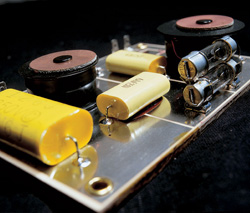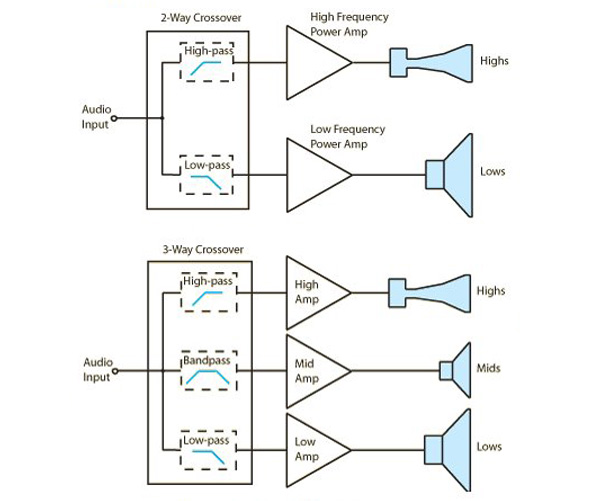
Active
Active crossover networks require a power supply to operate and come packaged in single-space, rack-mount units or more often in recent years, built into loudspeakers with power amplifiers.
Looking at the accompanying diagram shows how active crossovers differ from their passive cousins.
For a 2-way system instead of one power amp, you now have two, but they can be smaller for the same loudness level. How much smaller depends on the sensitivity rating of the drivers.
Likewise a 3-way system requires three power amps. You also see and hear the terms bi-amped, and tri-amped applied to 2- and 3-way systems.
Active crossovers cure many ills of the passive systems. Since the crossover filters themselves are safely tucked away inside their own box, away from the driving and loading impedance problems plaguing passive units, they can be made to operate in an almost mathematically perfect manner.
Extremely steep, smooth and well-behaved crossover slopes are easily achieved by active circuitry.
There are no amplifier power loss problems, since active circuits operate from their own low voltage power supplies. And with the inefficiencies of the passive network removed, the power amps more easily achieve the loudness levels required.
Loudspeaker jitters and tremors caused by inadequately damped back-emf all but disappear once the passive network is removed.
What remains is the amplifier’s inherent output impedance and that of the connecting wire. Here’s where the term damping factor comes up. [Note that the word is damp-ing, not damp-ning as is so often heard; impress your friends.] Damping is a measure of a system’s ability to control the motion of the loudspeaker cone after the signal disappears. No more dying fish.
Siegfried & Russ
Active crossovers go by many names. First, they are either 2-way or 3-way (or even 4-way and 5-way). Then there is the slope rate and order: 24 dB/oct (4th-order), or 18 dB/oct (3rd-order), and so on.
And finally there is a name for the kind of design. The two most common being Linkwitz-Riley and Butterworth, named after Siegfried Linkwitz and Russ Riley who first proposed this application, and Stephen Butterworth who first described the response in 1930.
Up until the mid `80s, the 3rd-order (18 dB/oct) Butterworth design dominated, but still had some problems. Since then, the development (pioneered by Rane and Sundholm) of the 4th-order (24 dB/oct) Linkwitz-Riley design solved these problems, and today is the norm.
What this adds up to is active crossovers are the rule. Luckily, the hardest thing about an active crossover is getting the money to buy one.
After that, most of the work is already done for you. At the most basic level all you really need from an active crossover are two things: to let you set the correct crossover point, and to let you balance driver levels. That’s all.
The first is done by consulting the loudspeaker manufacturer’s data sheet, and dialing it in on the front panel. (That’s assuming a complete factory-made 2-way loudspeaker cabinet, for example. If the box is homemade, then both drivers must be carefully selected so they have the same crossover frequency, otherwise a severe response problem can result.)
Balancing levels is necessary because high frequency drivers are more efficient than low frequency drivers. This means that if you put the same amount of power into each driver, one will sound louder than the other. The one that is the most efficient plays louder. Several methods to balance drivers are always outlined in any good owner’s manual.
Also see Exposing Mythology About Equalizers & Equalization by Dennis Bohn.
Dennis Bohn is a principal partner and vice president of research & development at Rane Corporation. He holds BSEE and MSEE degrees from the University of California at Berkeley. Prior to Rane, he worked as engineering manager for Phase Linear Corporation and as audio application engineer at National Semiconductor Corporation. Bohn is a Fellow of the AES, holds two U.S. patents, is listed in Who’s Who In America and authored the entry on “Equalizers” for the McGraw-Hill Encyclopedia of Science & Technology, 7th edition.

